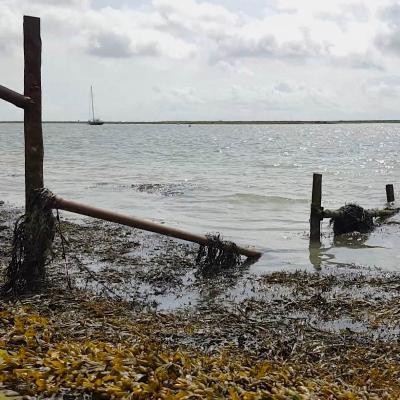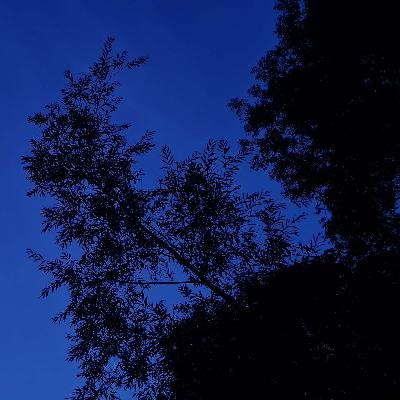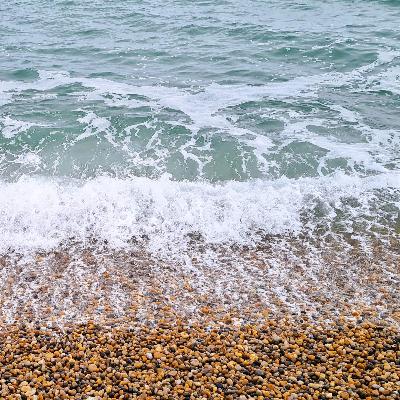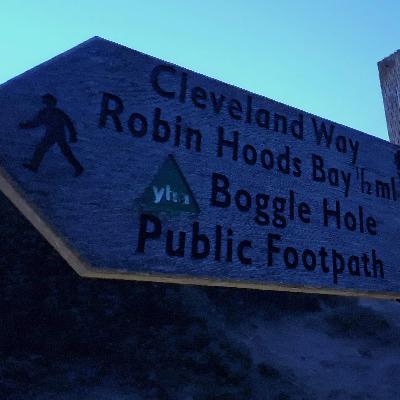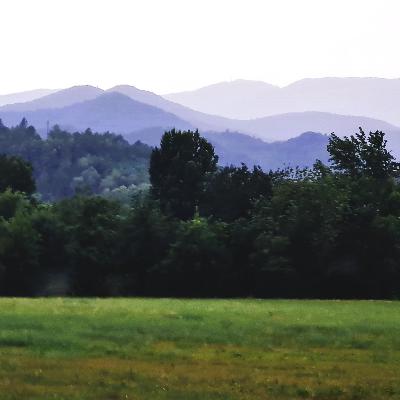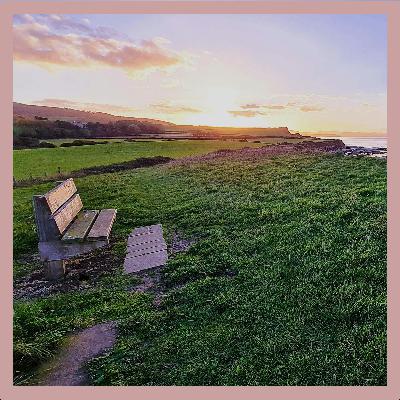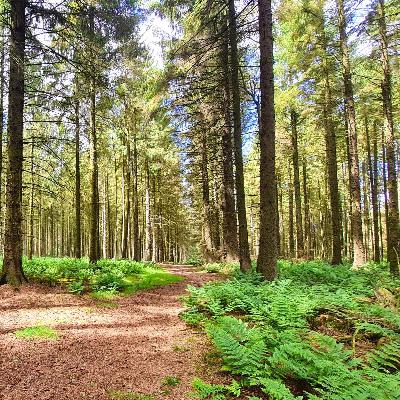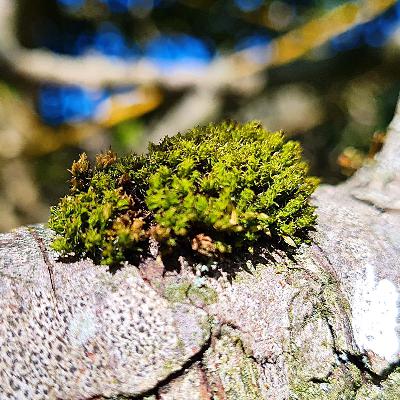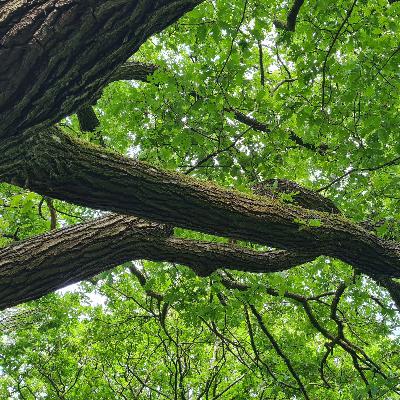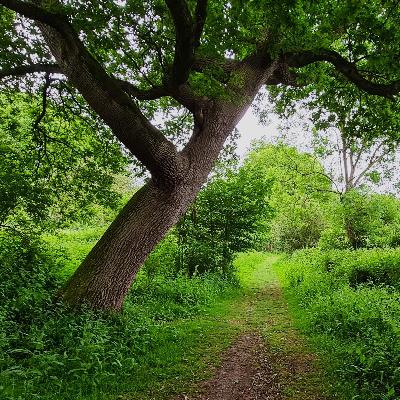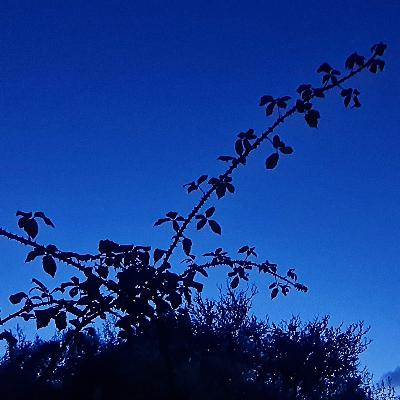Discover Radio Lento podcast
Radio Lento podcast

Radio Lento podcast
Author: Hugh Huddy
Subscribed: 156Played: 10,551Subscribe
Share
© Copyright 2023 All rights reserved.
Description
Surround yourself with somewhere else. Captured quiet from natural places. Put the ”outside on” with headphones. Find us on Bluesky @RadioLento. Support the podcast on Ko-fi.
291 Episodes
Reverse
Tied to a railing, the Lento box records alone. It's about two in the morning along the river bank east of Burnham-on-Crouch in Essex. Wind is blowing inland from the east, light, gusting to moderate. Sky dark, and heavy with cloud. Huge rainclouds are approaching, currently located out over the North Sea. When they arrive this whole area will be subjected to long periods of persistent, often squally rain, lasting well into the next day.
For now though the Lento box is dry. Its microphones capturing just the sound of the incoming tide as it steadily advances up the seawall. Angled directly towards Wallasea Island, the expanse of estuary water between the seawall and the opposite bank of the River Crouch can be heard as a wide and spatial backdrop.
Throughout this 30 minute passage of nocturnal time, the way the water plays along the seawall constantly develops and evolves. Sometimes individual waves form into resonant airpockets, producing fleetingly melodic notes. Wave energies surge and dissipate, surge and dissipate, edging closer and closer to the microphones on the rising tide. What's consistent is the timbre of the water as it washes over the rippled ridges of the seawall. To us silvery. Each individual wave captured in sharp spatial detail that you can experience in full using headphones or AirPods.
At twenty three minutes an aircraft approaches from the east and passes over Wallasea Island. From left to right of scene. Reveals across the empty void of the sky how human activity can still be heard over this otherwise wild and empty landscape.
* This sound photograph of the tidal River Crouch comes from a twelve hour non-stop overnight recording we made back in August 2021. For more sections of time from this same location please browse the Lento archive.
The still luminous sky above the sheer rock cliffs was turning an even deeper shade of blue, as we stepped down onto the wet sand of the beach at Boggle Hole. For a moment we just had to stand. Take it all in. Wide stretches of undulating sand. Half submerged boulders like sleeping elephants. Towering rock faces so vertical and so angled that they catch and reflect every breaking wave, every calling bird, every clack of a dislodged stone, back into your ears, so you hear them for a second time.
The tide's been receding for several hours. We turn right, and walk to find a good spot to record. We follow the band of newly exposed sand along the tidal zone, dodging pools of stranded water. See sea birds swooping, then landing, momentarily. Snatch up a morsel. Then they're up and flying again.
Herring gulls circle high overhead. Black headed gulls pass like projectiles, screeching for the empty air in front of them to get out of the way. Their bold cries caught, and reflected, by the plummeting cliffs of sheer vertical rock. This we know, we hear, we see, we feel, is a rarified place. A landscape of exceptional quality.
It doesn't matter how many hundreds of miles we have to go to find places like this, it's always worth it. Environments where extreme quiet and extreme spatialness coexist, together, for hours. Undisturbed. Uninterrupted. Unspoiled. We found a spot, then left the Lento box on a tripod to record the scene alone, in the gathering dark.
* We made this recording, or more accurately we took this sound photograph of Boggle Hole beach one evening last August whilst staying at the Youth Hostel. It's one of the most spatial sound captures we've made this year. Listen with headphones in a quiet place, and let yourself settle into the passage of time, to let your ears adjust and get the full spatial effect.
Capturing the sound-feel of real night quiet is special. It requires a lot of time and a location where quiet naturally occurs in more than just a fleeting way. Quiet is not silence. Silence is the absence of sound, whereas quiet happens when everything in the landscape is still audible. Just softer, and slower.
Night brings quiet to natural and edgeland places. It enables us to better hear an environment's true spatialness and blend of sound signatures. By tying the Lento box to a tree looking down over the Warren on the Kent coast and exposing the microphones for over 50 hours non-stop, long periods of naturally occurring quiet were captured that serve as a true impression of this place.
In this 90-minute passage of time taken from the dead of night on the second day of the recording, the sea can be heard distantly crashing onto the beach at the foot of the Warren. It surges and retreats, in slow unfurling rhythms. Close to the microphones, in the leaf litter around the tree, crickets call to each other in regular patterns, like naturally occurring clocks. Banks of wind blow in from time to time, gently ruffling leaves from left to right of scene. Sounds of indistinct origin sometimes echo across the valley, revealing the true width and depth of the space and far cries of seagulls, high flying in the vastness of the night sky.
Of course this is England, and only a short distance from France. The headlights of French cars are sometimes visible from this very point. The Strait of Dover is one of the busiest shipping lanes in the world, and a flight path runs directly over this area. Despite these mechanisms of human life, the planes that do overfly during this passage of time are quite gentle in the way they traverse the sky. It is the night quiet, and the sea, and the crickets that speak for themselves, and mean we just have to share this recording so everyone can be a sound-witness to the quiet of this place.
* We made this recording back in August 2024. We didn't actually intend to leave the Lento box out recording for so long (into a third day) but we're glad we did.
The making of this high-definition sound photograph of Chesil Beach began thanks to the number 1 bus from Weymouth to Portland. As we stepped aboard, the sky felt low. Folded and layered with grey October cloud. Rain was in the forecast so we'd taken raincoats.
After twenty minutes and the final stretch across the exposed coastal road, the bus pulled into our stop. On the way the views of Portland had struck an impressive sight, pointed bravely out to sea. It felt blowy off the bus as it always does here, but no rain, yet. We crossed the road, then up and over the largest shingle berm of any coastal area we know.
Dropping down more berms, scrunching over more acres of perfectly rounded pebbles, we and the Lento box finally arrived at the shoreline. Here is a soundscape that's beyond description. It takes a few minutes to acclimatise. Aural textures and flows wash around and through us, folding and layering like the clouds above. We'd forgotten how everything about this place engages the senses. Redefines what's normal. Resizes us into what we are. Tiny individuals, standing upon billions of even tinier stones.
The rain never came. Instead windows of blue opened and closed between the folds above. As the mics captured the scene The onshore breeze remained steady, letting the Lento box record every spatial and textural detail of the Chesil waves, only light winds buffeting.
The sea glowed turquois blue against the ruffled grey sky. Each rolling wave then turned pure white, as it broke over the beach of rich brown pebbles. The shore here stretches as far as the eye can see. To left of scene. To right of scene. Turquois. White. Brown. A unique place, with a unique soundscape, crystal clear, free of interfering noise thanks to the giant shingle berm.
* We made this on-location recording on Chesil Beach in Dorset just after 1pm on Wednesday this week. Special thanks to our friends and Lento supporters who live in Weymouth. They gave us a lovely welcome and a warm tea stop on our travels to make this recording. We feel it's one of the best sound captures we've made so far of Chesil Beach. further segments to follow in future episodes from this same location.
Reaching the top of Long Mynd in rural Shropshire requires a good steady climb. The rocky footpath winds up and up, and so must you, if you want to get to the top. Most people do, as much for that sense of physical achievement gained over an hour or two, as the views. 360 degree panoramic views of all that makes this whole area so special. But before you get to those views, there are many other fascinating sights to be had on the way up. And not only for the eyes.
Long Mynd is both a wild place and an area only lightly impacted by overflights. Once you are within the dramatic contours of this ancient landscape it is likely you'll encounter periods of near pristine quiet. Pristine quiet activates something fascinating in us, something we normally can't engage. Heightened aural awareness. Heightened aural awareness lets us fully connect with the landscape via our sense of hearing.
Hearing is a kind of touch sense. While we can feel the wind as it buffits against our faces and bodies, we are thanks to the wind, able to perceive trees and grasses even though they may be a hundred yards away. Wind presses through their physical shapes and structures producing sound vibrations that then physically land on our eardrums. It's like we are touching them, even though they are beyond the reach of our hands.
The higher you go up Long Mynd, the more you and the landscape are exposed to the elements. The wind surges stronger and stronger. Where the narrow and very steep footpath threads along the edge of rocks and a plummeting drop, the wind cannot be ignored. It is physical, and it is enlivening. It enlivens us, and it enlivens the trees and grasses. the birds. The hardy sheep as they graze the upland pasture. The tiny grasshoppers and crickets, only heard when the wind drops.
* We made this recording up on Long Mynd back in August. It's perhaps our most precipitous recording location so far! We carefully attached the box to a dramatic hawthorn tree overhanging one of the many sheer drops, just off the footpath. Hikers can be heard passing up and down the stony path. Right of scene the wild landscape slopes steeply up. Left of scene slopes steeply down into the valley below. Centre scene are trees on the opposite side of the cleft. Sheep graze on steep ground below the tree for a while, and a raven or large crow briefly passes. We think there's a stone chat there too. It's very difficult to capture sound landscapes in the face of such powerful wind gusts, but the wind really is the very essence of this wild place, and so we've made an extra effort to sonically balance the hugely varying loudness levels in this recording and share what we hope is a listenable sound view of Long Mynd in beautiful Shropshire.
Robin Hood's Bay on the North Yorkshire coast feels remote for England. It lies at the bottom of a very steep road that descends down from the road between Whitby and Scarborough. The sign at the top of the village warns sightseers interested in a look not even to try driving down. With virtually no traffic noise and the whole area under a quiet sky, we knew this was a good place for the Lento microphones.
The lane (we walked, obviously) winds very steeply down, passes a few little shops, a pub, a grocery shop with a jar part filled with fizzy drink to catch the wasps, and ends in a ramp onto the beach. Perfect waves break. Perfect because every detail can be heard cleanly, and precisely. No road or plane noise to get in the way.
Robin Hood's Bay was not actually our final resting point. For this we needed to walk about a quarter of a mile over the sand to the Youth Hostel at Boggle Hole. Delightfully named. Perfectly located.
Access across the beach is only possible when the tide is out. You know you're close when you reach a rocky stream that flows down from the cliffs. The last stretch, harder work. The stream is not walking boots friendly, uneven stepping stones look fun but need a confidence to use.
The Youth Hostel is tranquil. It really has the most peaceful surroundings of anywhere we've ever stayed. Above the hostel is a wooded area rich with rustling trees. As night approached we followed a tiny footpath up in between the trees. They swayed and hushed in the onshore breeze flowing up from the beach. We found a tree with a good trunk and tied the Lento box on to capture the sound of the night.
* This section of time is captured in the woods above the Youth Hostel. It's from 3am, early August. Weather conditions are warm and dry, with moderate winds gusting to strong. Dark bush crickets live amongst the trees. They can be heard all through the night. They can, if you feel like it, provide something nice to count, like sheep, to help you get to sleep.
The environment within the cabin of a sleeper train is, well, unusual. Quite contradictory. It feels empty when you first step in, but full seconds later. It has a dead quiet feel, whilst also being noisy. It affords little physical space to move about in, yet anything you accidentally drop ends up out of reach. It would feel claustrophobic too if it weren't also strangely spatial when the lights are out. It has bareness and simplicity that somehow affords comfort. And the cabin often rocks about, as do you.
The sound-feel within the cabin is unusual too. To start with there's rumble. Rumblings that roll constantly while the train is in motion. Sudden low frequency thuds and judders, as the carriages roll over joints and points in the track. There are regular pressure bumps in the internal air caused by trains passing close by in the opposite direction, and multiple strong humming sounds from the air conditioning and electric motors operating the train. Delicate sounds too. Tiny creaks and subtle shiftings in the fabrics and panelling that line the cabin, especially the ceiling which is made of flexible sound-absorbing slats.
To be conducive to sleep you'd have thought the cabin ideally needs none of this. Yet there is an intense stillness. And during your considerable time in the cabin, twelve hours and more, these aural qualities interact, and form into their own rhythms. The mental chemistry of it all reacts to produce soporific calm.
Set against my knees (as I slept) and the side wall of the cabin, with no inches to spare and bed clothes pushed up all around which would normally scupper any spatial recording, the Lento box recorded as the "night" began. Sleeping on a sleeper train is not like any normal night of course. The whole world around you is moving, rocking, as is everything in the soundscape. And yet you get your head into the comfortable hinged pillow (the back half goes up forming a bump protector) and you enter into a long aurally enhanced doze, that may, if you are lucky, become proper sleep.
Listening back the Lento box captured a true impression of being in a sleeper train cabin. Including occasional bed covers shifting and one of us popping out of the cabin briefly which is all part and parcel of the sound experience. This passage of time is somewhere between 3am and 4am. The train is speeding steadily across France, passing through lamplit towns and cities as it rolls on through the night. (It's hard to resist sleeping with the window blind part rolled up so you can witness these truly marvellous scenes.) The journey on this SNCF service is over 850km, departing Cerbere station on the extreme southern coast of France at 1850hrs, arriving Paris Gare d'Austerlitz at breakfast time the next morning.
>> We've just shared three minutes of video of the train gliding through the night. Watch on our YouTube.
Beside the only road leading out of Sant Llorenc de la Muga we found a small group of trees. We didn't have much time. The sky was pitch black and the ground beneath our feet was streaming with water that'd all come down a few minutes ago in a deluge with simultaneous flashes of forked lightening so powerful, so bright, they'd temporarily frozen us to the spot. We shone our torch from tree to tree, searching for a suitable trunk that might provide some shelter for the Lento box. The road was deserted. Traffic was not an issue. Only one more village lay beyond, where the road literally ended.
A patch of bare trunk came into view between rain soaked leaves. Around us every thing glistened. And dripped. Every shrub. Every branch. Every leaf. To the eyes and to the ears it was a rich sparkling sensory experience, that seemed interchangeable. Reaching through we tied the Lento box onto the trunk, angled it onto the wide landscape scene, and left it to record alone through the night.
This segment of time was captured from just before 3am to just after 4am. Heavy rain falls and the sky periodically grumbles with thunder, but eventually it eases off. To the right of scene one and sometimes more tiny beeps can be heard from time to time. We aren't sure what creatures make these delicately fleeting sounds. Frogs perhaps, lizards, or insects? The sounds are both soft and yet very distinguishable in the soundscape, and comforting for some curious reason. The medieval clock on the church of Sant Llorenc strikes the quarters and the hours through the night. Ancient bells seem even more enchanting when heard in the dead of night, and through crystal clear rain.
Our friends told us that in Sant Llorenc the weather changes towards the end of August. Endless days of thick summer heat gives way to something altogether more dramatic. Ominous black clouds the size of cities. Rain drops like translucent grapes. Fork lightening like you see at the cinema. Thunder, that carves open the sky, like unimaginably huge boulders crashing downwards from the high mountain peaks.
We followed the river Muga out of Sant Llorenc, into the valley beyond. Our aim was to reach a reservoir which we thought may be a good place to leave the Lento box to make an overnight recording. Eventually, along rough tracks surrounded by dense trees and noisy cicadas, we reached the water. Our way however was blocked. Two white horses.
Impressive creatures. Standing astride the track. They had their backs towards us. We stopped, and watched, and kept our distance. Despite facing the other way the horses knew we were there. In low voices we shared ideas on what to do, whilst continuing to watch. Both stood firm. They were expressing only the smallest of movements through their tails.
Some time passed. It felt like they were communicating something to us. But what? The valley with all its assorted cicadas seemed, somehow, to have fallen silent. We decided not to try to pass them. Something perhaps in the way they moved their tails said turn back. So we turned back.
Returning along the track we entered an area of the valley where the shallow river sounded unusually sonorous. The way the water tumbled over the rocks. the depth, and the particular arrangement of the trees. Just off the track a tree looked down into the gorge, so we tied the lento box to it. It was the perfect place for it to record. Perhaps, if we could have read the tails of the horses, this was what they were trying to say. Record back where you've come. Where it's sheltered. And where the river wrills. There's a storm. Coming.
For this second August intermission we've once again brought together multiple recordings made across a location to share as one very long non-stop piece.
This episode is our second ever "Lento Long". Three hours of spatial sound landscape captured from the Kielder Forest in Northumberland in the North East of England near to the Scottish border. It may all be sleep safe, depending on your own personal sensitivities to bird song which is prominent throughout the first 90 minutes. The latter 90 minutes is captured quiet from the night.
Here's a guide to what you'll hear.
- The episode opens with a daytime sound-view from an avenue of tall firs situated east of the giant Kielder reservoir. Banks of fresh morning air is pressing through the firs in soft hushing undulations, and bright birds are singing from everywhere.
- At 49 minutes you seamlessly travel over the water by five miles to the south west of the reservoir, to a densely forested area just below the Kielder Observatory. It's afternoon. The woodland ambience is alive with a white noise haze created by a clean rushing stream, countless willow warblers, and gentle surges of rich brown noise created as banks of wind filter through Grandis Firs some tall as 15 storey buildings.
- At 1 hour 36 minutes this Kielder day becomes Kielder night. Returning to the same peaceful location you were east of the reservoir, this time to experience the sound-view of the reservoir at night. Those pristine hours before dawn, when only owls and echoes roam the spaces between the trees, velvety hushes of rich brown noise waft down from avenues of tall fir trees, and nocturnal geese can be heard flying far out over the ink black water.
The episodes we blended together to make this Lento Long are 257, 247, 222 and 240, where you can read in detail about each location.
* Lento resumes a weekly service of captured quiet from new places in September. We have some gorgeous new locations to share with you! Thanks to everyone for listening.
It's August intermission time! This year we've decided to bring together recordings from more than one location in a specific geographic area and share them as a long non-stop episode.
This is our first ever "Lento Long" at 3 hours. A chance to aurally travel across a geographic area and experience it from different perspectives.
Depending on your own personal sensitivities to human made sound, it may be sleep safe. Children can distantly be heard playing on the beaches, and at just over an hour a microlight gradually drones over. For us this creates a wonderful sense of beach-time, where nothing in the world feels urgent anymore, but not everyone may respond in the same way so we haven't officially labelled this Lento Long as *sleep safe*.
Here's a guide to what you'll hear.
- The first hour is from the edge of the rocky beach at Lilstock in West Somerset, your back lent against a comfortable tree as the waves wash left to right with the longshore drift.
- At one hour this blends into the rarified ambience of Kilve beach at low tide, a soundscape carried into awareness with the gradual progression of a little microlight that slowly drones over high above.
- At one hour thirty, day becomes night. A weatherfront is passing over a remote cottage half way up West Quantoxhead. Fresh currents of Somerset air press freely through a bank of trees behind the cottage, setting their leaves and branches swaying, and hushing in richly undulating white noise.
- At just after two hours thirty, you invisibly reappear, sitting beside a secluded stream farther up the hill. You're listening to the pristine sound of water flowing off the top of West Quantoxhead, with the gentle company of two resting sheep nearby.
The episodes we blended together to make this Lento Long are 244, 254, 248, 255 and 249, where you can read in detail about each location. They were all recorded in late October 2024.
We'll release another Lento Long next week and resume the weekly service from the start of September.
Thanks to everyone for listening.
This week we're returning to Shelve Wood in Shropshire to witness another hour from the unaccompanied overnight capture we made in June. This section of time includes the effects of a strong weather front. It sweeps over the dense woodland, creating rich spatial waves of naturally occurring white, brown and grey noise.
Because the Lento box spent the whole night alone immersed within the forest, recording in high definition binaural sound, by listening back with headphones or Airpods we're able to aurally locate ourselves within Shelve Wood itself. Become aural witnesses. Hearing as if we are there, how time passed, surrounded by the trees. the sense of space. How each tree responds in its own unique way to the wind. And the rain drops, that find their way all the way down through the thick firs, to land on the forest floor.
* This section of time is from the early hours of the morning. The fir tree that held the Lento box was impressively tall. The Lento box captures the acoustical space of the forest facing outwards from the trunk, five feet (human height) above the ground. It's a vast reverberant zone that apart from the tree trunks, is essentially an empty space between the soft cushion of the forest floor and the ceiling of dense fir needles twenty feet above. In this zone the natural noises of the forest travel over long distances.
It's not often we record from the back garden. The spot is suburban. Grassy and full of tangled shrubs yes, and encircled by a sprawling wisteria too that visually at least gives a verdantly self contained feel. But foliage while beguiling the eye does not strain out the roads and street sounds of the city. Or the sky. Flight paved, plane lined, jet rumbled. No, quiet is never in abundance here.
At the end of last week, after a long run of bone dry conditions, the day came when rain was forecast. As day turned to dusk, the sky that'd been different shades of blue for so long, turned an opaque grey. The dark did not bring cool. If anything the air gained heat. As we set up the Lento box to record, the air moved around our bare arms and legs like warm weightless water. We could almost feel with our skin how the rain was starting to form.
We left the box alone on the grass, by the wisteria, to record all night. A night of half conscious dreams of rain, pounding on the roof. Of liberally flowing water. Of a loudly chortling drain. Of dawn birds singing through aural mists of green things dripping.
Listening back, witnessing the passage of time when the first rain began to fall, what struck us most was how delicious the first rain felt. Perhaps it's joy. The plants at last are having a drink. As time passes, other feelings come about. This is good rain. Heavy rain. Quenching rain. The birds will be able to bathe in shallow puddles gathered between roofs, and the world will sparkle, clean, when the light comes. But what we also gained from a long listen to this section of time, was the transition. How different the environment sounds and feels towards the end. Echoes and a pleasant sheen of aural silkyness. And endless things dripping. And what we didn't expect to hear, bees starting their days from the very first rays of daylight. And hints of swifts screaming overhead.
A bright April day has dawned in Derbyshire earlier in the spring. The air is unusually still for this time of year and this upland location. At just under a thousand feet barely a breeze is ruffling the trees surrounding the mics. These are the same trees that can be heard so powerfully in episode 250 - Moorland trees in mid-winter gales.
Far across the valley, stretching from far left to far right of scene, a country road threads its way over the moors. It links the small Derbyshire town of Whaley Bridge to the busier Cheshire town of Macclesfield about seven miles away. Due to a major land slip and road closure on the next valley, there is less traffic, though you can hear occasional cars threading the tarmac way through the landscape from time to time.
Mid left down the field, a woodpecker. In the same copse, a song thrush. From different points in the mid-distance seesawing great tits. Wrens too, and wood pigeons, and a chif chaf, and a pheasant. Deep in the valley, geese can be heard over the reservoir. What made this segment of the overnight recording feel special though was the blackbird.
As time passes the blackbird lands on a branch of the apple tree directly above the Lento box, and sings so sonorously. And then does it again, as if it knows how special it is to witness a singing blackbird so close.
(pronounced Birr Island)
This long, slow Devon day, is drawing softly to a close. Looking out to sea, the sky beyond has already fallen velvet black. It's midnight. Scattered lamps shine on Burgh Island. It looks from here more like a dark thicket, afloat on a vast water field. With glow worms, hiding.
The tide's in now. Closed around the island. Encircled it, with rich undulating sound. Filled up the wide sandy beach, for as far as the eye can see, with swirling shallows. Ankle deep. As the sea meets itself coming in across the causeway, it splashes up fingers of crisp white spray.
Some gulls are still aloft. High wheeling, but mostly quiet. Silently weaving between the stars. Riding on the diurnal winds. the off-shore breeze, or land breeze, created by the land-sea temperature contrast that happens at this time of night.
* As with all Lento episodes it can take several minutes for your listening brain to properly switch into the soundscape. This one hour segment is from an overnight recording we made in April. The Lento box is perched on a second floor balcony looking straight down the causeway towards Burgh island, which is only about 200 yards from the box. Due to the topography of the beach and how it contours around the island, the sound-shape of the sea is interestingly different to other coastal locations we've captured. The breakers form and gather spatially, often very slowly, with long periods of swirling eddies in between. High tide is reached towards the end of this segment. Moderately strong wind gusts sometimes buffer the microphones. As a recording location it is exposed. We've applied some spot rumble reduction when this happens just to improve the experience for headphone / Airpod listeners.
Oak trees have a very particular sound this time of year. It's to do with the leaves. Their texture, shape and contours. How they catch and filter the breeze. On a warm spring day, like this one the Lento box captured last month in rural Shropshire, you can hear the softness of the moving air sonified by banks of oak leaves.
The scene around the microphone box, tied to the trunk of a relatively young oak tree, is endlessly rural. Ahead, over a bank thick with tangled shrubs, a wide field, vibrant green, is dotted with sheep and lambs. Song birds sing out from around the small nature reserve. A place called Poles Coppice. A point on the landscape with many neatly hidden well occupied perches. Birds are like nothing else. Their songs illuminate dusky shadows between the trees. And carry far. Over fields, bathed in late afternoon sun. And sheep, dutifully grazing
* Poles Coppice nature reserve is quite remote and has a lovely sound-feel, thanks to its resident birds and oak trees. the country road that can sometimes be heard mid-left of scene (far distant) leads to a small town called Minsterley. When that day last month we set out to capture the spring sound of Shropshire we auditioned various locations before eventually stumbling upon this particularly peaceful little place. Thank you to the guardians of Poles Coppice who created this nature reserve. We are so glad to be able to share its natural sound.
** Poles Coppice is officially #LentoApproved.
Experiencing the spatial sense of emptiness, in a natural place, when there's nobody about, endlessly fascinates us. We built a high resolution immersive sound capture device to study it. We find natural places to leave it out recording alone, to capture quiet scenes in sound. Of time passing.
We are all intrinsically hyper-attentive to the possible presence of people within our surroundings. Any movement that might signal another person in the vicinity, fundamentally changes our thoughts. It deflects our mind's eye from fully connecting with the place. This is why we always set out to record in largely uninhabited locations that are good sources of naturally occurring sound.
Before Lento came about, the question of whether or not a falling tree makes a sound when there's no one around to hear it, proved puzzlingly difficult to argue in classroom discussions. If only we could send back in time this sound-scene of Shelve Wood in Shropshire, that we recorded last month. Yes, remote listening is a thing. Be there and yet not be there to hear the trees. Slow banks of shifting air, brushing softly, panoramically, through the firs. And every drop of rain, that finds its way down, between the branches, to land on the soft dry carpet of the forest floor. Shelve Wood has an acoustic that conveys space. A vast space. It is a space that, especially at night, murmerates with deep, velvety echoes. Hushes. Thousands of conifers and spruce, moving together, in natural sympathy with the wind.
* This section of time is from a 12-hour overnight recording we made last month in beautiful Shropshire. The fir tree that held the Lento box was impressively tall, and peaceful.
This soundscene was captured two weeks ago from a rackety wooden fence beside a grass meadow. Reeds are growing to right of scene, waving and hushing in strong gusts of spring warm wind. Centre, a view out across the meadow. Left of scene, over a rough track and an overgrown strip of marshy land is the Thames Estuary. Above, from time to time, skylarks. Hidden not too far off in a thicket, a cetti's warbler. Various other birds come by, each a pleasure to hear, with its own unique estuary sound.
It's a scene that feels wide open and exposed. It's lashed by the weather. Strong gusts and breezes, and quick whispering winds. But being the end of May, it's warm. The sun is radiant. Its energy heats the ground, creating deliciously warm sweetly scented banks of moving air. Thermals, that the birds use to rise easily into the sky. The Thames, at this point sprawling wide as a lake, provides navigation not just for ships but for aircraft. Fortunately only a few pass over during the time of our recording. This is what nature along the Thames Estuary, from a rackety fence wobbling in the wind, really sounds like.
* Thanks again to Lento supporter Ian for taking a day to drive us and the Lento box out to the Thames Estuary. Getting to remote locations so we can capture and share the sound-feel of being there is what Lento is all about. And it ought to be quite a straightforward process. Check map for a nice looking location. Travel out to it with recording gear. Set up, press record, wait about for around an hour, then return home, listen to the captured soundscape and publish! The weird thing is despite having recorded at over a hundred different physical locations, we still haven't quite worked out how to persuade birds to sing on cue, wind not to gust out of control, rain to fall just when we want it, and cars planes and people to vacate the area while we are recording...
Whilst out along the Kent side of the Thames Estuary on Saturday, aiming to capture the sound of skylarks and reeds, we met a walker with a very friendly border terrier. She told us there was talk of a nightingale not too far away at RSPB's Northward Hill Nature Reserve. We aren't strictly speaking wildlife recordists, the Lento box is designed like a wide angle camera to capture panoramic landscape sounds, but we thought it might be worth a visit to the reserve to see if we might be able to find it.
Unusually for us public transport devotees, we were able to travel on to Northward Hill easily thanks to a magnificent Lento supporter. He'd driven us and the Lento box out from Brockley station in South East London to explore another corner of the Hoo Peninsula, and was keen to visit the reserve. We didn't feel hugely confident about actually hearing a nightingale. They are the kinds of birds you don't expect to find on demand.
We rolled into the reserve's car park and quickly headed down into the woodland. We descended a rough flight of bare earth steps under the dark shadows of dense tree canopy, surrounded by glorious birdsong. All the usual suspects of course, familiar if you regularly listen to Lento - chif chaf, blackbirds, black caps, jackdaws, robins, various others plus trusty wood pigeons.
After turning right and proceeding further into the woods over a few hundred yards our ears pricked up. I found myself saying "and there it is" before I had even properly heard it. We continued for a few steps and, fortunately, there it was again, this time much more clearly, and without doubt a nightingale only about thirty yards away! Up on the tripod went the Lento box. I turned it to face the sound of the nightingale, and pressed record, bathed in the rich tapestry of spring woodland birds, coming from all around us.
Here's what the box captured. It's only twenty minutes. The passage of time is from around 5pm on 24th May. There are some people vaguely audible and a horse (louder) somewhere to left of scene. A road must pass the reserve too because some level of vehicle noise is distantly audible, but not so much as to spoil the overall effect. We capture whole landscapes from one fixed position, so what you hear is the nightingale just as we heard it from standing on the path and facing into the reserve. Wildlife recordists find ways to post their microphones very close to their subjects and as such we are all used to hearing nightingales proportionately far louder than anything else. In reality though these are not birds that like being approached, so few people can ever actually hear in-person, the bird singing as loudly as they do in specially focused recordings.
With a pair of headphones though this episode provides a realistic woodland soundscape with a nightingale almost dead centre of scene. You should be able quite easily to hear it between the other birds which are spread out to the left and to the right of scene. Listen out for a wonderfully special coincidence that happens a few times where a distant cuckoo comes into earshot too. It is pretty well dead centre, behind the nightingale.
There must be a farm nearby because several cockerels crow towards the end. The whole scene is in fact very busy, and whether a connection or not, I note how the nightingale seems to become more active when the chif chaf is in full voice. Coincidence, or not?
This bonus episode is shared with big thanks to our trusty supporter and to the dog walker we met.
At this spot, high up on The Warren, in the dead of night, live the crickets. They're everywhere. Stridulating, like tiny minute hands etching the moments, of this night's time passing. Crisp. Unwitnessed. They're probably dark bush crickets.
The Lento box records the scene alone, on a warm night last August. Tied to a very difficult tree. Difficult because it was very spiny. And off the path, part way down a precipitous drop. Why not an easier tree? Because of the view. This tree looks out over the valley, over all the tree tops, towards the hushing sea, far below.
Time passes. Somewhere in the valley, an ocean breeze lows in. Shifts a bank of trees into a state of gentle rustling. Countless crickets mark the moments. Then from nowhere a nocturnal train materialises in the bottom of the valley, right of scene. It glides across, and into the left horizon. Further and further. Until finally, it dissolves, and becomes just another part of this place's subtle, and natural murmurings. Perhaps a hedgehog is moving in the bushes. And a hint of a plane, heading south east towards France.
* This 50 minute section is from a 48 hour recording we made in Folkestone Warren last August. It captures a deeply peaceful scene of this green and tangled place, by the sea, and the endlessly breaking waves of the Channel. Listen carefully (with headphones or airpods) and you may catch sound of a lower pitched cricket to left of scene. We still aren't sure what exactly it is, but it sounds like the cicadas in old films from 1950s America.


